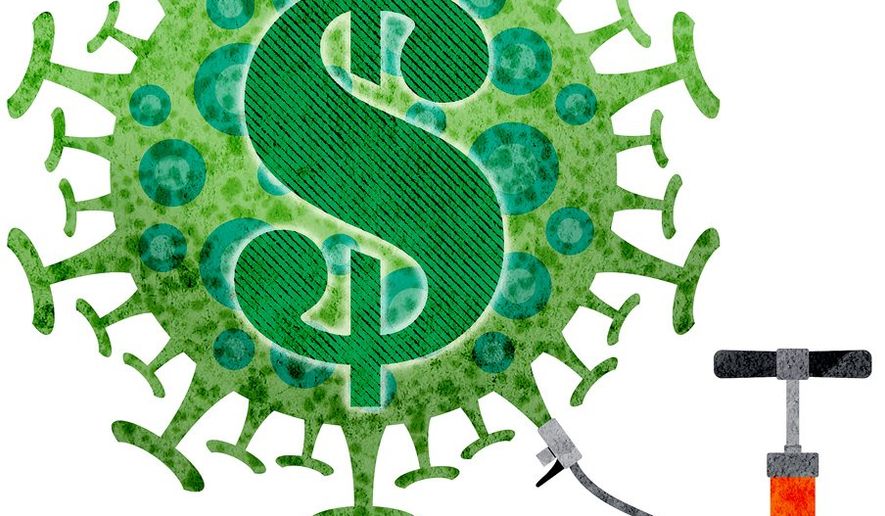OPINION:
Federal Reserve policymakers shouldn’t lower their guard. Inflation isn’t dead.
September’s consumer price index was up just 2.4% over 12 months prior, but core inflation, which takes out volatile food and energy prices, hung stubbornly at 3.3%.
Rents for apartments and houses increased 4.9%, while prices for other services, excluding energy, increased 4.5%.
Prices for essential services such as health, car and homeowners insurance and diversions including concerts and amusement parks continue to rise briskly.
Three lessons from COVID shockflation bear mentioning.
First, price surges have lasting effects on consumer psychology and business behavior.
New York Federal Reserve, Conference Board and University of Michigan surveys put one-year expected inflation just above 3%, which is in line with core inflation and well above the Fed’s 2% target.
Expectations must be taken seriously because those affect workers’ posture in wage negotiations and businesses’ strategic planning. Consider the outsized demands of Boeing workers and the company’s generous multiyear offers.
Central bank bouts with rising prices across many economies indicate that inflation is a vampire that must be killed with a wooden stake through the heart in its coffin, or it will wreak havoc again.
Excess capacity, a property crisis and slack demand in China have suppressed goods prices globally, but the Fed should monitor services and consumer expectations as it eases policy to avoid a recession.
Second, policymakers should take ownership of their mistakes — or risk repeating them and not being credited for their successes.
Former President Donald Trump and President Biden spent $4.5 trillion on pandemic relief. To support them, the Fed purchased a similar amount of Treasurys and other securities and greatly increased the money supply.
That juiced consumer demand — especially for goods in short supply thanks to workplace shutdowns in China and here — and caused inflation to accelerate to 9.1% by June 2022.
Pandemic relief was excessively generous. Consequently, workers were slow to return when COVID-19 shutdowns ended, exacerbating upward pressure on wages and prices.
Instead of admitting it overspent, the Biden-Harris administration continued to run up the federal deficit with the CHIPS and Science Act and Inflation Reduction Act. This year, the budget gap is 7% of gross domestic product, compared with 4.6% before COVID-19.
With businesses ramping up spending on artificial intelligence, increased private investment and federal debt will compete for new savings in capital markets. Either the Fed lets interest rates settle considerably above pre-pandemic levels or we get more inflation.
Ms. Harris persistently blames inflation on price gouging by large investors in residential real estate applying algorithms to set rents and big supermarkets exploiting shortages when the evidence is scant.
Bloomberg’s economists found that grocery margins fluctuated from the pre- to post-COVID periods but remained mostly flat. Margins were hardly correlated with spikes in grocery prices during the pandemic.
Algorithmic pricing is widespread — consider how the airlines and Amtrak adjust fares. Banning AI could easily result in less-efficient fare adjustments to ration scarcity during peak demand and fewer discounts when seats are plentiful, limiting opportunities for lower-income travelers.
Championing Luddite policies — such as banning AI — and scapegoating businesses may score points with Ms. Harris’ progressive base, but it limits her credibility with swing voters.
By the end of 2023, GDP was back to where the Congressional Budget Office had forecast just before the pandemic, and this year, the economy continues to add jobs at a robust pace.
In swing states, unemployment is generally below what was just before COVID-19 and the national average.
Yet voters give the Biden-Harris administration terrible marks on the economy and inflation. As Ms. Harris struggles to separate herself from Mr. Biden in voters’ minds, she also struggles against Mr. Trump in swing-state voter preference polls.
Third, economics is surely corruptible.
A cottage industry has emerged that attempts to discredit “neo-liberal economics” and lend currency to the New Monetary Theory notion that we can print money to spend ever greater sums on social programs.
Cecilia Rouse, who served as Mr. Biden’s chair of the Council of Economic Advisers and now heads the Brookings Institution, has marshaled considerable resources to attempt to show that the recent inflation was caused by supply shortages — “especially a rise in company margins” — and not excessive COVID-19 relief policies.
That’s like saying prices are high because prices have gone up. It’s circular reasoning.
Margins rise when supplies are short. That’s how prices ration, and they should fall back when supplies normalize.
That won’t happen as much when lots of money gets printed and consumers are locked up for months and then spend windfall savings as the economy reopens.
Progressives will do just about anything to avoid admitting we can’t enjoy a European-style welfare state without taxing working- and middle-class people at levels comparable to those across the Atlantic.
• Peter Morici is an economist and emeritus business professor at the University of Maryland and a national columnist.
For more information, visit The Washington Times COVID-19 resource page.




Please read our comment policy before commenting.